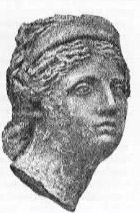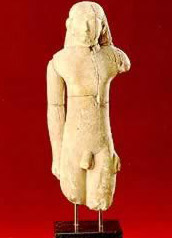Nikratj (Greek Naukratis, modern Kom Gi'eif)
by Jimmy Dunn

Nikratj (Greek Naukratis, modern Kom Gi'eif) was a Milesian Greek settlement on the Canopic branch of the Nile in the Western Delta. However, scholars believe that Corinthians may have early on inhabited the city, with the Milesian Greeks arriving later. The City is located about 16 km from Sais, the capital of the 26th Dynasty. Nearby, there is a modern village that seems to have preserved the ancient name as el-Niqrash.
In his documentation of Naukratis, Flinders Petrie states that:
The question of the position of Naukratis has long been an undecided one; and for the very good reason that no part of the world, so close to a large Western population, and so essential to archaeology, is such unknown ground as the Delta of Egypt. There are hundreds of English travelers who are familiar with Upper Egypt and its downs; but it would be easier to find anyone to give a scientific personal account of the sources of the Nile, than one who could give an archaeological account of the remains thickly scattered about its mouths.

The problem is that thousands upon thousands of years of flood waters and dampness in Egypt's Delta has destroyed most of the monuments in the area, and those that remain are often buried beneath a thick layer of silt.
Herodotus tells us that Ahmose II gave the site to the Greeks, along with a monopoly on sea trade to Egypt. He also tells us that it was the first and only city in which the early Greek merchants were allowed to settle and so from that standpoint along the city has considerable historical importance. However, historians believe that Ahmose only reorganized an existing settlement of foreigners, providing them with new trading privileges. We know of the city's existence from at least 688 BC due to a passage of Athenaios in which he mentions a merchant of Naukratis trading there from Cyprus in the twenty-third Olympiad.Besides, Herodotos tells us that Ahmoses "gave the city of Naukratis ", indicating that the city existed to be given. In fact, Petrie provides some evidence that the city existed from a very remote time, though most of his earliest discoveries appear to date no earlier than the middle of the seventh century BC.

In some respects, Naukratis may be more famous from a Greek standpoint than from the Egyptian side. It is often referenced in modern accounts of ancient Greek colonization and we know that it was an important and busy trading center that granted Greks access to Egyptian grain and luxury items. However, it was obviously under strict control of the Egyptian pharaoh, and the town is important from the standpoint of understanding Graeco-Egyptian relations during the seventh and sixth centuries BC.

The Site was excavated by Flinders Petrie in 1884-1885 and was later investigated by F. Li. Griffin and D. G. Hogarth in the 1980s. Apparently work continues today. We are told by Amelia Ann Blanford Edwards in her publication, Pharaohs Fellahs and Explorers that it was famous for the skill of its potters and the taste of its florists! She tells us that Petrie turned up inscriptions, coins, sculptures, bronzes, terra-cottas and other treasures at the site. An interesting story has Petrie coming upon the remains of a jeweler's workshop, containing a quantity of lump silver, and a large store of beautiful archaic Greek coins, fresh from the mint of Athens. The coins were never in circulation, and were probably intended to be made into jewelry.However, there were probably some coins actually struck in Naukratis, and these would comprise the only coinage known from Pharaonic Egypt.
The so-called stele of Naukratis, a perfectly intact stele, was unearthed on the site a little over a century ago (1899). Interestingly, and also uniquely, an identical stele was recently found during the underwater excavations off the coast of Alexandria. The engravings on the stele, now located in the Egyptian museum, are particularly fine. The stele contains a decree of Nectanebo I relating to a levy of ten percent tax on good coming into the port at Naukratis, as well as goods manufactured in the city. The tax was for the benefit of the temple of Neith (at Sais). Some account give Naukratis a complete and absolute monopoly on foreign sea trade during this period.

Some structures still exist at the site, including the temples of Dioscuri, Apollo, Hera and Aphrodite, as well as a scarab factory. However, there is really very little to see, as most of these facilities are in complete ruin. Nevertheless, study of the ruins will probably continue for some time due to the importance of the city.

